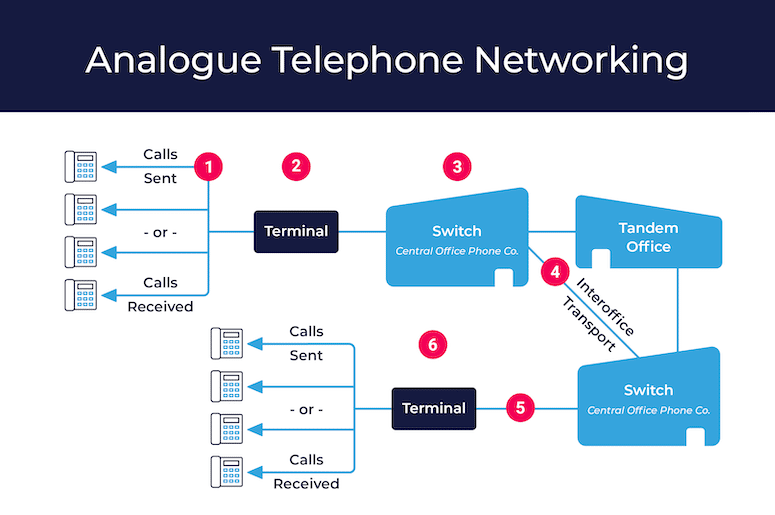Enter your email address to receive the latest ITVET news, market insights, and useful IT tips.
Is your business ready for the analogue phone line switch-off deadline? In 2027, the UK will hang up on the Public Switched Telephone Network (PSTN) for good and switch to fully cloud-based solutions. This is an exciting opportunity for businesses, but failure to prepare can create significant issues. In this article, we’ll tell you everything you need to know about the upcoming changes and how ITVET can help you prepare.
PSTN switch-off delay
As companies gear up for the analogue phone line switch-off, BT has announced that they are delaying the switch-off to January 2027. This gives them an extra two years to ensure a smooth and safe transition for their vulnerable customers and telecare users. BT will gradually switch customers to digital services, prioritising safety and reliability, with full-fibre broadband available to 25 million premises by the end of 2026.
Who does the analogue phone switch-off affect?
The telephone switch-off impacts everyone, at home and at work. And it’s not just your phones you need to think about. It’s everything currently connected to your old phone network, such as door entry systems, lifts, CCTV, EPOS machines, and much more. For businesses, this is an incredible opportunity, but without careful preparation, 2027 could be a year of chaos, disruption, and unprecedented costs.
What is an analogue phone line?
The analogue phone line, Public Switched Telephone Network (PSTN), is an aggregation of the world’s circuit-switched telephone networks. The traditional system relies on underground copper wiring or, more recently, fibre optic cables to transmit information from one location to another. Traditionally, PSTN was the most reliable way to make phone calls, and it had a host of other uses. Do you remember dial-up internet?
In 2017, BT announced a phased approach for the PSTN switch-off, and they have already started the process. The switch is happening everywhere, not just in the UK. Estonia and the Netherlands have already completed this switch, and countries like Germany, Japan, and Sweden are making good progress.

What is cloud-based VoIP?
So, what is cloud-based VoIP? Voice over Internet Protocol (VoIP) delivers communications using your internet connection. When making a call, your voice converts into a compressed digital signal and is sent over the internet. This digital data is then uncompressed into sound on the receiving end.
Why is the PSTN switch-off happening?
PSTN has been around since the 1800s and is out of touch with the demands of modern communications. Technology and the way we communicate have dramatically changed over the decades. The BT analogue switch-off reflects how businesses work in a remote climate of instant messaging and video calls, while the use of emails and cold calls is in steady decline.

Benefits of using VoIP
The move to digital is better for us in the long run. One of the main benefits of using VoIP for business is that it’s cheaper to buy, run, and maintain. Traditional phone systems are expensive. VoIP doesn’t require a separate system or additional hardware. It simply uses an existing internet connection. As well as cheaper infrastructure, it also dramatically reduces call costs, especially when it comes to international calls.
VoIP also offers enhanced features and benefits you don’t get with traditional phone systems. For example, VoIP provides you with the ability to customise your communications and divert calls across your team using an online portal to manage call traffic.
One of the other main benefits of using VoIP is that it uses the cloud. This means you can make calls and access your systems on any device, from wherever you are, helping facilitate remote working and business continuity.
What systems does the BT analogue switch-off affect?
When you assess your property portfolio, you’ll soon see that analogue technology is much more than your phone system. Many key systems still use PSTN to enable them to work. This means the BT analogue switch-off will have a huge impact.
Systems that run on an analogue telephone line may include:
- Door entry systems
- Lifts
- CCTV
- Alarms
- EPOS machines
- Payment systems
- Lifts
- Footfall counters
- Temperature sensors
Lots of these systems, including fire alarms and lifts, are high priority. It’s essential to migrate them away from analogue with careful analysis and reconciliation of all services and connections. This comprehensive audit should be conducted by business communication experts like ITVET to minimise downtime and avoid power cuts and emergencies.

Is there any rush?
2027 seems like a long way off yet, but there’s a lot to do. Don’t let the PSTN switch-off deadline creep up on you. Start planning now to prevent any disruption and downtime.
The benefits of planning now
- Minimise disruption time – Careful planning ensures minimal disruption to key systems like your access control system and lifts when switching from analogue to digital. This may include spacing out the on-site work and prioritising back-end solutions to introduce the digital connection. At ITVET, we use a case-by-case plan with a bespoke approach to remove all analogue technology. It takes cautious inspection and planning of each system to ensure a seamless transition.
- No downtime – Cautious planning helps avoid downtime. Careful consideration of every part of your business ensures that all your systems move to digital by the deadline.
- You have more time to balance out the costs – With a three-year deadline, you have time to agree and implement budgets. For example, property managers have time to construct a plan that works for them, such as altering the service charge for their tenants.
- More time to construct outside-the-box solutions – The phasing out of analogue lines before the complete PSTN switch off doesn’t mean you have to purchase brand new hardware. We have innovative solutions to create a new digital connection. This involves retrofitting your hardware, which is better for the planet than buying brand new and has huge cost savings. For example, we use an Analogue Telephone Adapter (ATA) device, which converts the signal into an IP mode, allowing the service to continue.
How can ITVET support your PSTN migration?
At ITVET, we see the analogue phone switch off as an exciting opportunity to seize change and think outside the box. Digital solutions open the way for innovations and efficiency, and they’re more user-friendly than their traditional counterparts.
Here’s our approach
- Bespoke plan – We understand each case is different and requires a different timeframe and strategy. We coordinate our bespoke plan through a systems audit, on-site visits, back-end monitoring, and constant communication.
- Support all the way – Our IT support team is truly accessible. There’s always a human voice at the end of the phone at any time. Our 1st, 2nd, and 3rd line engineers are trained to a higher technical standard than is expected within our industry, enabling them to resolve complex, strategic service requests quickly and efficiently.
- Smooth plan with minimal downtime – We’ve completed these projects multiple times in preparation for the complete analogue phone switch-off in 2027. With our extensive experience and cautious planning, you can expect a smooth PSTN migration that doesn’t impact your business.
- Sustainable solutions – We prioritise the planet in how we work. To do this, we think outside the box, using sustainable solutions such as retrofitting analogue hardware.
Is your business ready for the UK’s 2027 analogue phone line switch-off? Don’t wait – get expert help today and ensure a smooth Transition! Speak with a VoIP consultant today!












